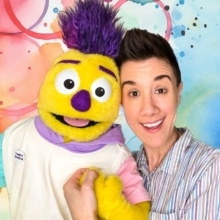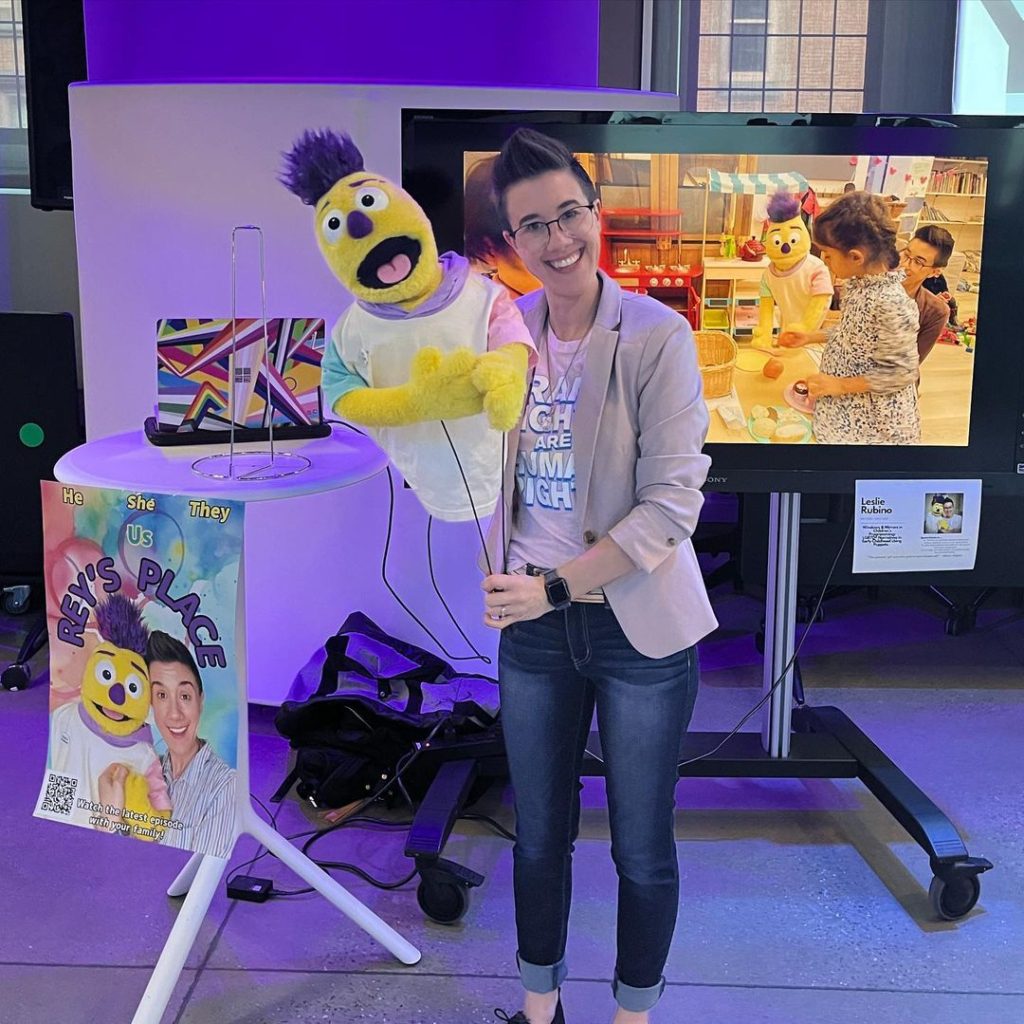When Children and Educators Can Both Be Their Truest Selves, That’s Pride

Leslie is the creative developer of a non-binary puppet named Rey, who they use in the classroom with young children to encourage freedom of expression and inclusivity.
From the time I was in Kindergarten and throughout my high school years, I did everything I thought a young girl would do: I wore makeup, skirts, and pink.
I even got my first perm (I probably should have listened to my mom, but what teenager does?) because I thought this was what it meant to be female. I had this notion that since I was assigned female at birth, I needed to “look” and “act” female to gain positive or negative attention. The problem was, even with all of the jean skirts and the bedazzled tank tops (The 90’s, am I right?) I never felt right. I didn’t feel like me.
However, how could I explain that to someone when I didn’t even have the vocabulary to describe who I was? The thought of discussing gender identity and/or even having transgender students in our schools was non-existent, while the queer youth who did come out as gay or lesbian were targeted for bullying and abuse. It wasn’t safe, and I was afraid of being another target.
It wasn’t until the pandemic that I was able to understand what it meant to live under the transgender umbrella. I discovered the term “two-spirit”, a person who embodies the feminine and masculine spirit, and, suddenly, my childhood and adolescence began to make sense. During this time, my wife was also on her own gender journey when she came out to me as a transgender woman. This time gave us the opportunity to open up and look back at our childhood.
With memories flooding of this queer child just looking for someone to look up to or relate to, I kept coming back to the question, how can we support queer children in the early years?
Leslie Rubino
Facing Their Fears
When I made the decision to go back for a Master’s in Education, I knew I wanted to focus on early childhood education with an emphasis on learning how to queer teaching practices in the early childhood classroom. I was given the opportunity to work at the early childhood center on campus as a graduate teaching assistant, which would allow me to provide an environment that was inclusive and supportive of all children while also being open about my own identity with my students and colleagues.
While I am fortunate to teach at one of the top research institutes in the country, being an LGBTQ+ educator or an LGBTQ+ student in America is, at many times if not all the time, scary. There is an underlying fear for your own safety in a space where one is told you are safe. However, this is not the case for many states in our countries.
According to the Trans Legislation Tracker, there have been 69 anti-trans bills passed out of the 541 proposed across the country. Of those, 52 out of 69 have been signed into law and 17 others passed, but haven’t yet been vetoed or signed. This is just in 2023 alone. In Florida, the violent rhetoric of the “Don’t Say Gay Bill” bans educators from teaching lessons regarding sexual orientation and gender identity from K – 12. It is an attempt to dehumanize children and adults who “dare” to understand their identity and live freely and happily in their true selves.
But the truth is, no matter how much content is removed or banned, queer people have always existed and will continue to exist. It is just a matter of being given the opportunity to exist in spaces we occupy daily, for example, schools. Early childhood educators have the opportunity to start that welcoming journey for those children and their families.
Leslie Rubino
The fear and hesitation that I have heard from other preschool teachers are “How is that appropriate? My school won’t allow me to talk about gender” and “What about the parents? I might get in trouble.” Of course, these are inherent fears, but there are great techniques that I have used to bring more inclusive practices and resources into the classroom.
For example, I use they/them pronouns and I had the opportunity, during our free play, to explain to my students “Some people feel like a girl in their heart or a boy in their heart, and some people might feel like neither or both, and that’s me!” To build off of the teachable moment, I provided literature and narratives of characters with different gender identities such as being non-binary and transgender, and I left space for questions.
Getting Creative
This provided me with the opportunity to create an out-of-the-box integrative project for my Master’s Program. I created a non-binary puppet named Rey to bring into the classroom, along with creating and producing a pilot of Rey’s Place, where Rey spends time in my preschool classroom with my students just existing as themselves while also providing moments for my preschoolers to learn about identities outside of their own.
They learned not to assume someone’s gender just by the way they look on the outside and how to support and advocate for non-binary and transgender students if they are being bullied. The ultimate goal is to provide inclusive identities and narratives for educational media that provides young children with stories that use windows and mirrors, where a student can either see themselves reflected in the story or they look through the window of a different narrative they might not have known before.
Letting children play and explore through their own experiences in the classroom without intervention gives children the opportunity to be free; free from stereotypes, free from gendered practices, and free to learn.
Leslie Rubino

Looking Forward
Programs and lessons centered on inclusive LGBTQ+ narratives are extremely important in the early years because they can provide a safe and welcoming environment for queer students to see themselves reflected and provide inclusive language practices for all members in the classroom to better understand and support gender non-conforming students. But most of all, children can just be children.
And above all, listen to children. Listen to how they speak in different social settings, how they play, what they read, and what triggers emotional distress. As adults, we say we know what is best for us because only we know ourselves. The same goes for children. Children are more intuitive than we think, and allowing them the freedom to explore and express themselves in their truest form is one of the best opportunities we can provide for our children.
I think about my inner child and what would have happened if I were granted the opportunity to express myself outside of my sex at birth. That was why I created a space and program for young queer children like me. It can grant them not only the opportunity to learn about their identity but also allows them the opportunity to love themselves early on in their lives. And that is pride.
